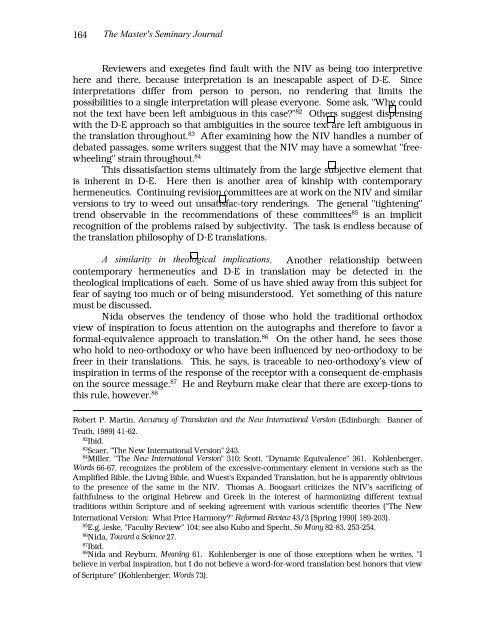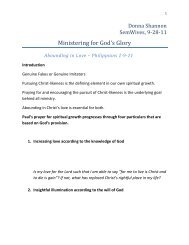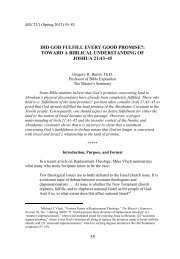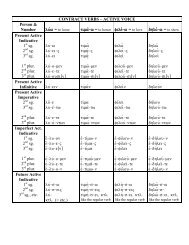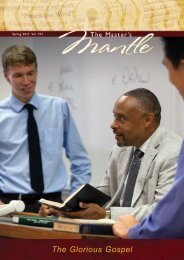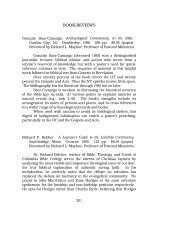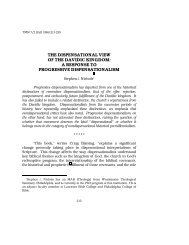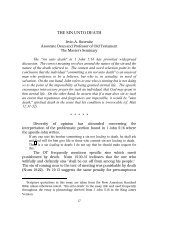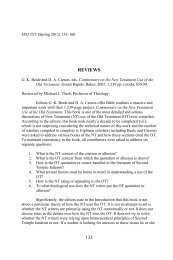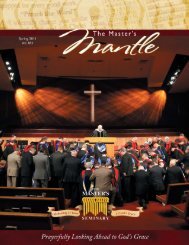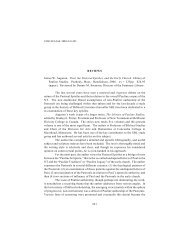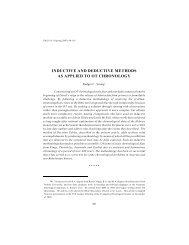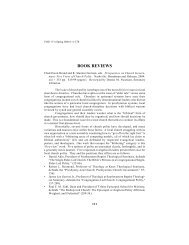164 The Master's Seminary JournalReviewers and exegetes find fault with the NIV as being too interpretivehere and there, because interpretation is an inescapable aspect <strong>of</strong> D-E. Sinceinterpretations differ from person to person, no rendering that limits thepossibilities to a single interpretation will please everyone. Some ask, "Why couldnot the text have been left ambiguous in this case?" 82 Others suggest dispensingwith the D-E approach so that ambiguities in the source text are left ambiguous inthe <strong>translation</strong> throughout. 83 After examining how the NIV handles a number <strong>of</strong>debated passages, some writers suggest that the NIV may have a somewhat "freewheeling"strain throughout. 84This dissatisfaction stems ultimately from the large subjective element thatis inherent in D-E. Here then is another area <strong>of</strong> kinship with contemp<strong>or</strong>aryhermeneutics. Continuing revision committees are at w<strong>or</strong>k on the NIV and similarversions to try to weed out unsatisfac-t<strong>or</strong>y renderings. The general "tightening"trend observable in the recommendations <strong>of</strong> these committees 85 is an implicitrecognition <strong>of</strong> the problems raised by subjectivity. The task is endless because <strong>of</strong>the <strong>translation</strong> philosophy <strong>of</strong> D-E <strong>translation</strong>s.A similarity in theological implications. Another relationship betweencontemp<strong>or</strong>ary hermeneutics and D-E in <strong>translation</strong> may be detected in thetheological implications <strong>of</strong> each. Some <strong>of</strong> us have shied away from this subject f<strong>or</strong>fear <strong>of</strong> saying too much <strong>or</strong> <strong>of</strong> being misunderstood. Yet something <strong>of</strong> this naturemust be discussed.Nida observes the tendency <strong>of</strong> those who hold the traditional <strong>or</strong>thodoxview <strong>of</strong> inspiration to focus attention on the autographs and theref<strong>or</strong>e to fav<strong>or</strong> af<strong>or</strong>mal-<strong>equivalence</strong> approach to <strong>translation</strong>. 86 On the other hand, he sees thosewho hold to neo-<strong>or</strong>thodoxy <strong>or</strong> who have been influenced by neo-<strong>or</strong>thodoxy to befreer in their <strong>translation</strong>s. This, he says, is traceable to neo-<strong>or</strong>thodoxy's view <strong>of</strong>inspiration in terms <strong>of</strong> the response <strong>of</strong> the recept<strong>or</strong> with a consequent de-emphasison the source message. 87 He and Reyburn make clear that there are excep-tions tothis rule, however. 88Robert P. Martin, Accuracy <strong>of</strong> Translation and the New International Version (Edinburgh: Banner <strong>of</strong>Truth, 1989) 41-62.82Ibid.83Scaer, "The New International Version" 243.84Miller, "The New International Version" 310; Scott, "Dynamic Equivalence" 361. Kohlenberger,W<strong>or</strong>ds 66-67, recognizes the problem <strong>of</strong> the excessive-commentary element in versions such as theAmplified Bible, the Living Bible, and Wuest's Expanded Translation, but he is apparently obliviousto the presence <strong>of</strong> the same in the NIV. Thomas A. Boogaart criticizes the NIV's sacrificing <strong>of</strong>faithfulness to the <strong>or</strong>iginal Hebrew and Greek in the interest <strong>of</strong> harmonizing different textualtraditions within Scripture and <strong>of</strong> seeking agreement with various scientific the<strong>or</strong>ies ("The NewInternational Version: What Price Harmony?" Ref<strong>or</strong>med Review 43/3 [Spring 1990] 189-203).85E.g. Jeske, "Faculty Review" 104; see also Kubo and Specht, So Many 82-83, 253-254.86Nida, Toward a Science 27.87Ibid.88Nida and Reyburn, Meaning 61. Kohlenberger is one <strong>of</strong> those exceptions when he writes, "Ibelieve in verbal inspiration, but I do not believe a w<strong>or</strong>d-f<strong>or</strong>-w<strong>or</strong>d <strong>translation</strong> best hon<strong>or</strong>s that view<strong>of</strong> Scripture" (Kohlenberger, W<strong>or</strong>ds 73).
Dynamic Equivalence . . . 165There is little doubt that the assured conviction that the Hebrew, Aramaic,and Greek autographs <strong>of</strong> the Bible are inspired, lies behind the dominance <strong>of</strong>f<strong>or</strong>mal-<strong>equivalence</strong> <strong>translation</strong>s throughout the centuries <strong>of</strong> Christianity. ThePhiloxenian, Harclean, and Palestinian Syriac Versions are early examples <strong>of</strong>eff<strong>or</strong>ts to conf<strong>or</strong>m the <strong>translation</strong> to the <strong>or</strong>iginal text f<strong>or</strong> this reason. 89 Thetheological motive behind this type <strong>of</strong> <strong>translation</strong> is obvious. 90The presence <strong>of</strong> such a motive can be seen in the reactionary nature <strong>of</strong> some<strong>of</strong> the early-twentieth-century free <strong>translation</strong>s. M<strong>of</strong>fatt in the preface <strong>of</strong> his free<strong>translation</strong> <strong>of</strong> the NT associates his freedom in <strong>translation</strong> <strong>method</strong>ology with being"freed from the influence <strong>of</strong> the the<strong>or</strong>y <strong>of</strong> verbal inspiration." 91 Phillips justifies hisapproach in a similar way in the preface to one <strong>of</strong> his paraphrases: "Most people,however great their reverence f<strong>or</strong> the New Testament may be, do not hold a w<strong>or</strong>dby-w<strong>or</strong>dthe<strong>or</strong>y <strong>of</strong> inspiration. . . ." 92Another symptom <strong>of</strong> a relaxed attitude toward biblical inspiration is theattitude <strong>of</strong> D-E advocates toward the source languages <strong>of</strong> Scripture. Nida andTab<strong>or</strong> view these languages as being no different from any other languages. Theymake a strong point that Hebrew and Greek are subject to the same limitations asany other natural language. 93 This point is valid, but it is only part <strong>of</strong> the picture.These biblical languages are the only ones that God chose to communicate inspiredScripture and are theref<strong>or</strong>e unique among all languages. Why, then, do D-Eadvocates criticize those who believe in biblical inspiration and put these89B. M. Metzger, The Early Versions <strong>of</strong> the New Testament (New Y<strong>or</strong>k: Oxf<strong>or</strong>d, 1977) 65, 69, 80.90de Waard and Nida, From One Language 10. Carson's statement is surprising: "Why a literal<strong>translation</strong> is necessarily m<strong>or</strong>e in keeping with the doctrine <strong>of</strong> verbal inspiration, I am quite at a lossto know" (D. A Carson, The King James Version Debate [Grand Rapids: Baker, 1979] 90). The churchhas long felt that inspiration elevates the <strong>or</strong>iginal texts to the point that a <strong>translation</strong> should reflect asmuch <strong>of</strong> them as possible, as reflected in Mink<strong>of</strong>f's careful analysis <strong>of</strong> the goals <strong>of</strong> the LXXtranslat<strong>or</strong>s and Jerome in biblical <strong>translation</strong> (Mink<strong>of</strong>f, "Problems" 35-36).91J. M<strong>of</strong>fatt, The New Testament, A New Translation (1913) vii.92J. B. Phillips, The Gospels Translated into Modern English (1952) 5. It may be coincidental, but theearliest f<strong>or</strong>mulation <strong>of</strong> D-E the<strong>or</strong>y coincided with the espousal <strong>of</strong> new the<strong>or</strong>etical proposalsregarding inspiration among evangelicals. It was just one year bef<strong>or</strong>e the appearance <strong>of</strong> Nida'sToward a Science <strong>of</strong> Translating that Earle wrote the following in the ETS Bulletin: "The w<strong>or</strong>ds are notthe ultimate reality, but the thoughts which they seek to convey . . ." (R. Earle, Bulletin <strong>of</strong> theEvangelical Theological Society 6/1 [Winter 1963] 16). He continues by observing that Paul's struggleto find adequate w<strong>or</strong>ds "acc<strong>or</strong>ds well with the view <strong>of</strong> plenary <strong>dynamic</strong> inspiration`much betterthan it does with plenary verbal inspiration" (ibid.).It was also roughly contemp<strong>or</strong>ary with similar developments in other realms. Just seven yearsafter Nida's initial eff<strong>or</strong>t at establishing a the<strong>or</strong>etical basis f<strong>or</strong> D-E, Richard Buffum, in one <strong>of</strong> hisregular columns <strong>of</strong> the Los Angeles Times, wrote, "Contemp<strong>or</strong>ary journalism is learning to perceive asubtle spectrum <strong>of</strong> grays between the old black and white rep<strong>or</strong>ting techniques" (R. Buffum, LosAngeles Times [Oct 5, 1971]). He defines "subtle spectrum <strong>of</strong> grays" as a new "kind <strong>of</strong> ponderous,inf<strong>or</strong>med subjectivity" that journalists are using in place <strong>of</strong> "the old rigidly `objective approach'"(ibid.).These other developments probably had nothing directly to do with the development <strong>of</strong> D-E, but they p<strong>or</strong>tray the spirit <strong>of</strong> the age that indirectly spawned the D-E philosophy.93Nida and Taber, The The<strong>or</strong>y 7.


